Common menu bar links
CLIENT SEGMENTS
This section presents variations on key issues explored in the survey for different Service Canada client segments. The client segments included in this analysis, including the number of respondents in each group (identified in brackets) are:
-
Aboriginal Canadians (N = 131)
-
Persons with disabilities (N = 383)
-
Members of visible minorities (N = 290)
-
New Canadians (N = 109)
-
Seniors (i.e. 60 or older) (N = 1,205)
-
Youths (i.e. 18-30 years old) (N = 661)
-
Working-age adults (N = 2,842)
The following graph presents the distribution of surveyed clients by client segment. Note that respondents could be in multiple client segment groups (e.g. someone can be a youth and a person with disabilities).
Overview
On the whole, differences by client segments were neither pervasive nor wide. Differences that did manifest themselves tended to distinguish one or two groups from others, and tended to be related to behaviour or experiences more than perceptions. In terms of behaviour, for example, seniors were the most likely to have used a single channel to initiate contact during the past six months and to have made contact only once during this period. However, along with persons with disabilities, they were the most likely to have made contact regarding three or more programs/services. Perhaps not surprisingly, persons with disabilities and seniors were the most likely to have used the telephone to contact Service Canada, and seniors were the least likely to use both in-person service and the Internet. As might be expected, youth were the most likely to have used the Internet.
Levels of satisfaction with the overall quality of service were similarly high among most client groups, with the exception of persons with disabilities and Aboriginal Canadians. Seniors were most likely to provide strongly positive feedback in most service-related areas, while members of visible minorities were the least likely to do so. Along with Aboriginal Canadians, they were also the least likely to strongly agree that staff were courteous, gave them what they needed, and went the extra mile to get them what they needed. Aboriginal Canadians were least likely to attribute a positive impact to the new, one-stop model of service delivery represented by Service Canada.
Q74: Are you a member of any of the following groups?
Q75: How long have you lived in Canada?
Satisfaction Across Client Segments Largely Consistent, Lower for Aboriginal Cdns.
There were generally only minimal differences in terms of the levels of satisfaction with the overall quality of service received across the different client segments. Five of seven of the client segments have satisfaction levels of 84-85%. Only two were below this – persons with disabilities (79%) and Aboriginal Canadians (74%). Moreover, approximately half or more of the respondents in each group were very satisfied with the service received. Levels of dissatisfaction with the overall quality of service ranged from 5-12%, and only reached double digits for Aboriginal Canadians.
Q25: How satisfied were you with the overall quality of service you received from Service Canada related to…. [INSERT PROGRAM/SERVICE USED] during the last six months? Please use a 5-point scale, where
Variations in Other Key Areas
Awareness of Service Canada
The following graph presents awareness of Service Canada by client segment. Awareness was highest among youth, disabled Canadians and working-age adults, and lowest among Aboriginal Canadians, new Canadians and seniors.
Reasons for Contacting Service Canada
Not surprisingly, certain client groups were more likely to contact Service Canada for certain services. For example, seniors were most likely to contact the government regarding a CPP Retirement pension, the OAS, and the GIS. Similarly, persons with disabilities were most likely to contact the government regarding CPP Disability. Youth and working-age adults were most likely to initiate contact regarding EI. New Canadians were most likely to initiate contact regarding a SIN. Members of visible minorities were most likely to initiate contact regarding a passport. Use of 1-800 O’Canada was highest among Aboriginal Canadians and persons with disabilities. Contact regarding Employment Programs/Assistance was similar across all client groups (14-18%), with the exception of persons with disabilities (9%) and seniors (3%).
Q2: What is the name of that department?
Q3: Service Canada, created in September, 2005, has primary responsibility for providing services to Canadians on behalf of the Government of Canada. Have you heard of this organization?
Service Channels Used
Persons with disabilities and seniors were the most likely to use the telephone to contact Service Canada (69-73%), with members of most other client groups similarly likely to have done so (60-64% vs. 54% of New Canadians). New Canadians were most likely to contact Service Canada in person (65%). Members of visible minorities, youths, and working age adults were similarly likely to do so (43-47%). It was less likely to be used by Aboriginal Canadians and persons with disabilities (30-32%), and least likely to be used by seniors (24%). Seniors were also the least likely to use the Internet (16%), while youth were most likely to have done this (51%).
The following graph presents channel use by client segment:
Seniors were the most likely to be single-channel users (65%), although a majority of persons with disabilities, Aboriginal Canadians, and members of visible minorities were also single channel users (52-58%). The following graph presents the number of channels used by client segment:
Q8: During the last six months, in which of the following ways did you contact Service Canada? Please focus on contact with the government itself, nervice received through another organization delivering programs or services funded by the Government of Canada. How about [insert service channel]?
In terms of the average number of contacts across all channels (both including and excluding the Internet), seniors were the most likely to have had fewer contacts with Service Canada during the previous six months. The frequency of contact among other client segments was quite similar.
Q9: How many times in the past six months did you [insert service channel]?
Number of Services Used
Youth were most likely to contact Service Canada regarding one service (63%), although so did a majority of working-age adults, Aboriginal Canadians and members of visible minorities. Persons with disabilities and seniors were most likely to make contact regarding three or more services (32-35% vs. 13-26% of others).
Perceptions of Service
Seniors were most likely to provide strongly positive feedback in 13 of 15 service-related areas. Differences in strongly positive perceptions between other client groups did not tend to be large (5-9% in most service-related areas). That said, members of visible minorities were least likely to provide strongly positive feedback in most of these areas (8 of 15). This included: being treated fairly, receiving information that is clear and easy to understand, being informed of everything they needed to do to receive the service, receiving consistent information/advice, knowing what to do in the event of a problem or question, confidence about personal information being kept confidential, satisfaction with the time it took to get service, and accessibility to service. Moreover, along with Aboriginal Canadians, they were least likely to strongly agree that staff were courteous, gave them what they needed, and went the extra mile to get them what they needed. Aboriginal Canadians were most likely to disagree that the information they received was clear and easy to understand, that they were informed of everything they needed to do to receive the service, and to have received consistent information or advice.
Received What They Needed
Disabled persons, followed by Aboriginal Canadians and seniors, were the least likely to say they received everything the needed.
Q26: In the end, did you get what you needed?
Problems with Service
The likelihood of encountering problems with service during the previous six months did not vary much by client segment (10-16%), and was lowest for seniors, and highest for Aboriginal Canadians, youth, and members of visible minorities.
Satisfaction With Specific Programs/Services
Client segments in which fewer than 50 individuals used a specific program/service were not included in the comparison. This resulted in the exclusion of 2-3 client groups for most services. EI is the only service for which the comparison includes members of all client groups. At the other extreme, results for CPP Disability include only two groups: persons with disabilities and working-age adults.
Satisfaction with service related to SIN was very high across groups (88% or higher), as was satisfaction with the quality of service received when calling 1-800 O’Canada (85% or higher). Satisfaction with the quality of service received in relation to EI also did not vary much across groups (74-80%). Satisfaction with the quality of service received for a CPP Retirement pension was similar across all groups (83-86%), with the exception of persons with disabilities (71%). Satisfaction with service related to the OAS was similar across all groups (84-88%), with the exception of working-age adults (79%). Youth and working-age adults were most likely to be satisfied with service related to Employment Programs/ Assistance (73-76% vs. 67% of members of visible minorities). Seniors and working-age adults were more satisfied with service related to a passport than youth and New Canadians (82-84% vs. 77%). Finally, working-age adults were more satisfied than persons with disabilities regarding service related to CPP Disability (78% vs. 72%).
Q27: During the past six months, were there any problems with the service you received from Service Canada?
Perceived Impact of Service Model on Quality of Service
The following graph presents information about the degree to which different client segments were informed by Service Canada staff about other programs or services that might be of interest to them. This was done least often with respect to Aboriginal Canadians and seniors, and most often with respect to members of visible minorities, disabled Canadians and new Canadians.
The following client groups were more likely to attribute a positive impact to the new, one- stop model of service delivery represented by Service Canada: New Canadians, persons with disabilities, members of visible minorities, and seniors. A majority in each of these groups (53-58%) said the new approach to service delivery had a positive impact on the quality of service they received. Aboriginal Canadians were the least likely to think this (36%), and the most likely to see no impact on service quality (54%). Perceptions that the impact was negative varied little across client segments (4-8%).
Q69: When you contacted Service Canada to obtain information or service during the past six months, did service staff inform you about any other programs, services or information that might be of value or use to you?
[ previous | table of contents | next ]

 D
D D
D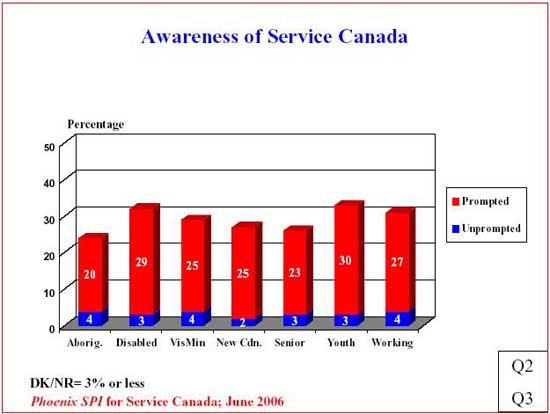 D
D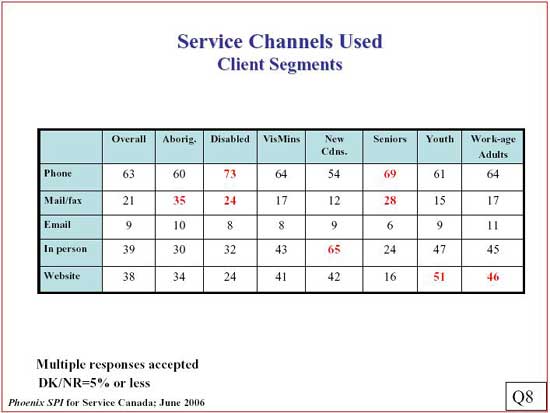 D
D D
D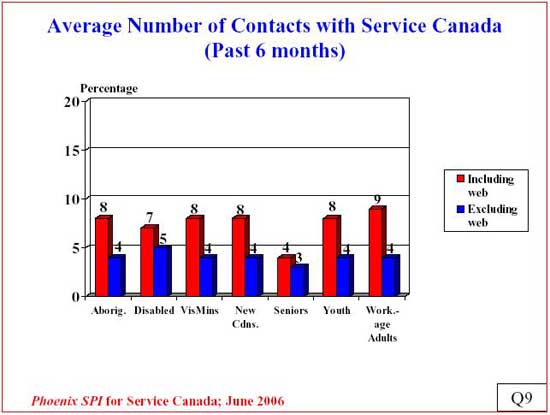 D
D D
D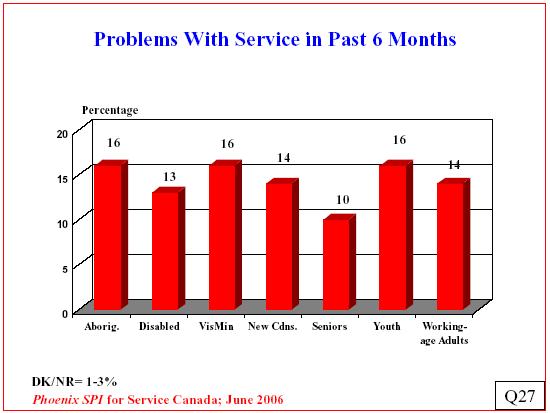 D
D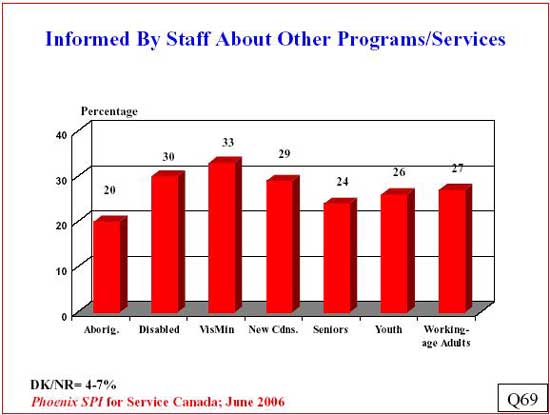 D
D